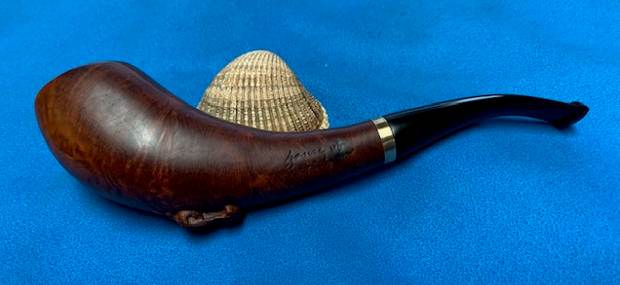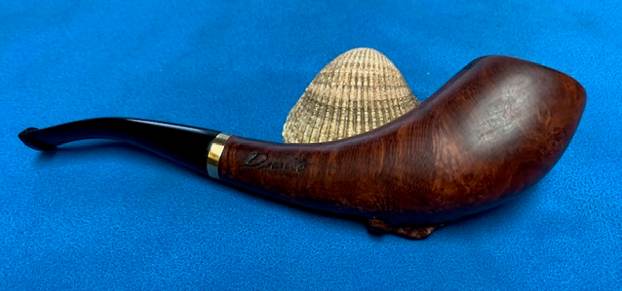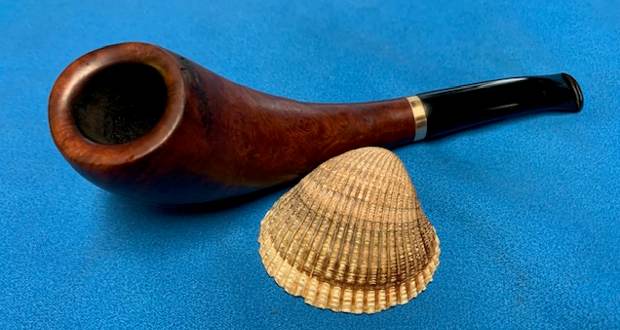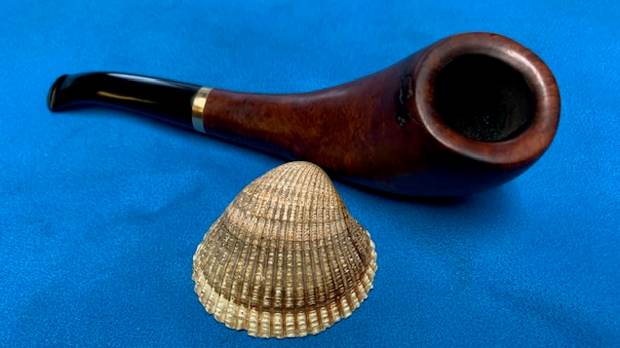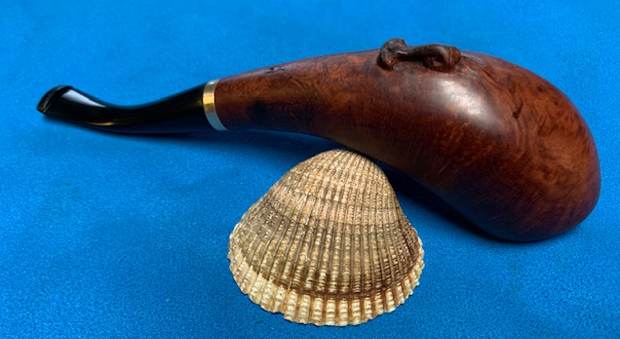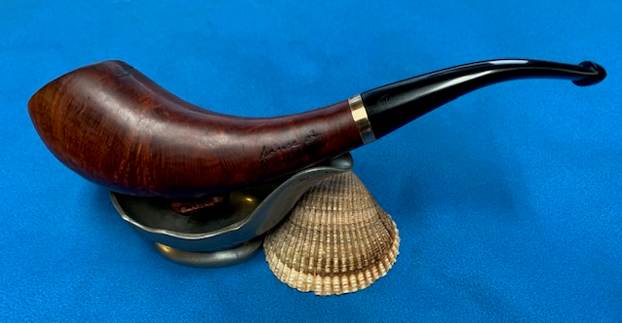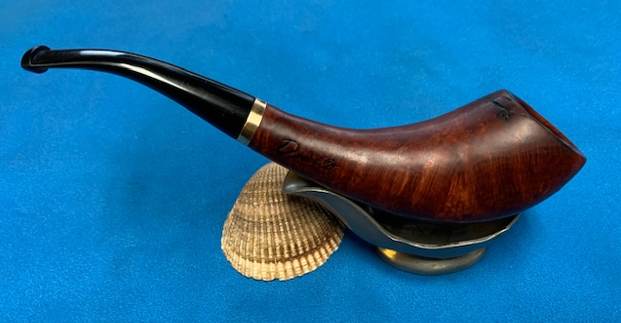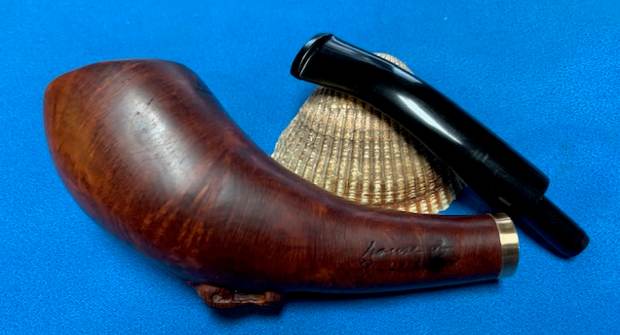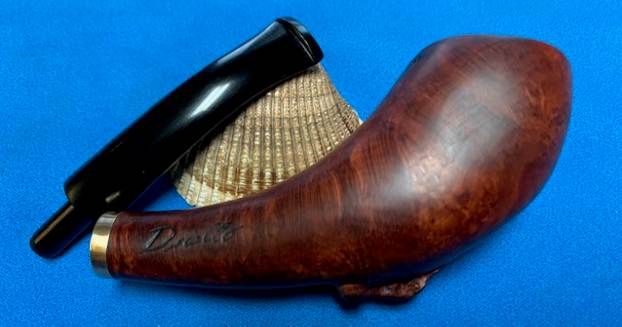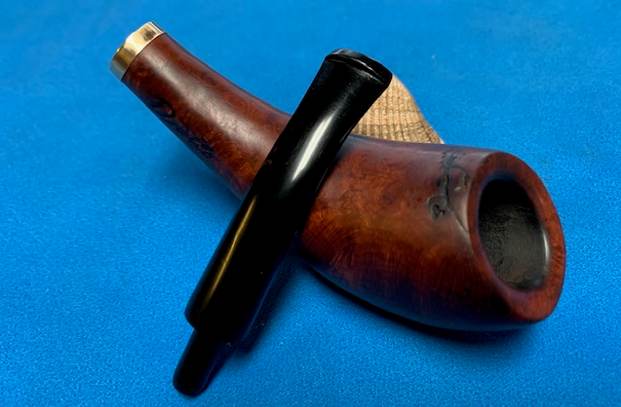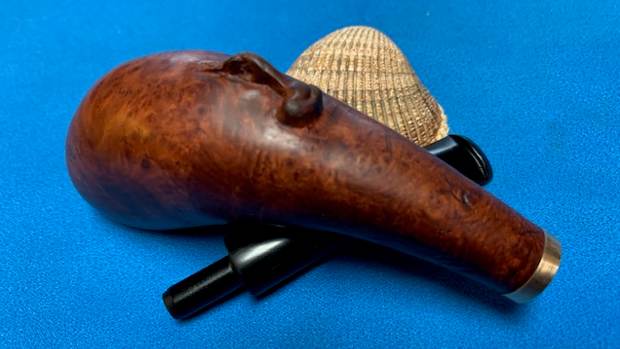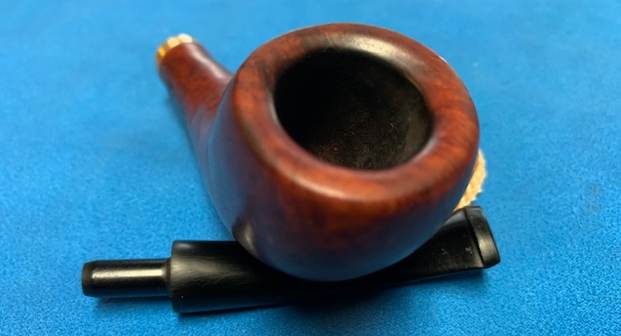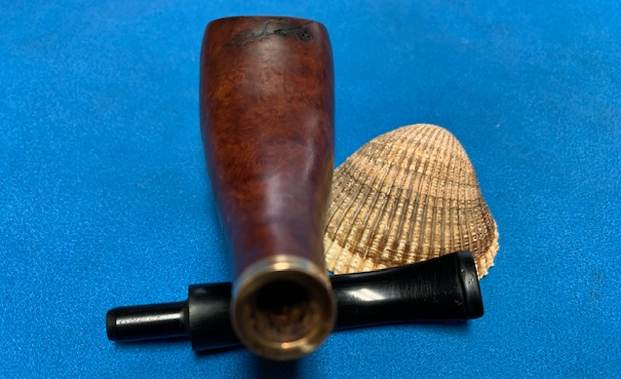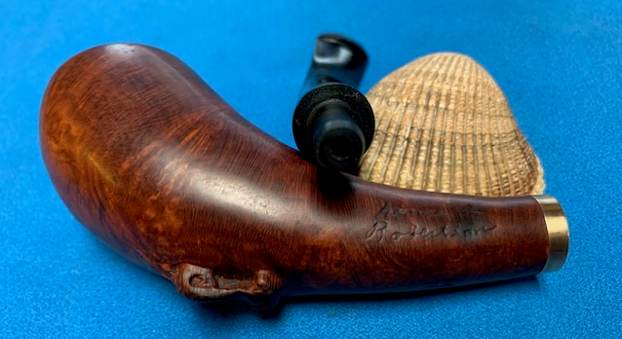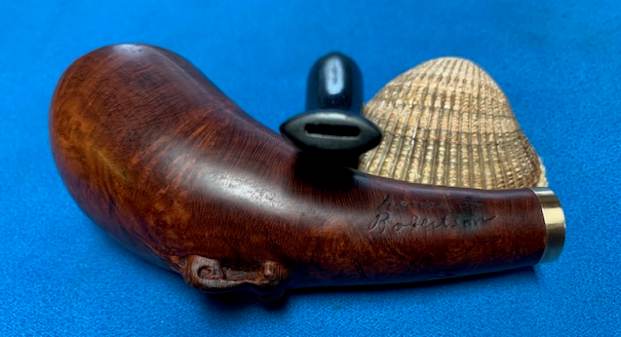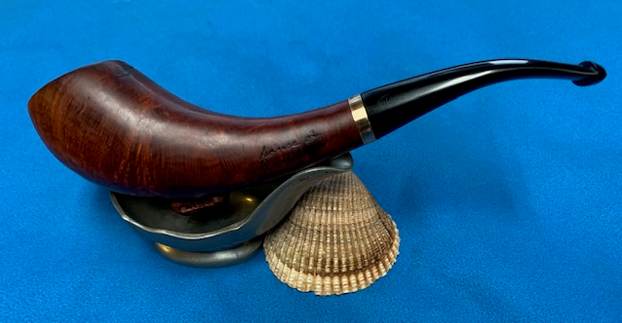Blog by Steve Laug
This very beat up, large, long House of Robertson Horn Shape Pipe is the next pipe I chose to work on. We purchased it on EBay on 10/31/22 from a seller in Abita Springs, Louisiana, USA. It is quite different from the other pipes from this Boise based store that I have worked on. It is a Horn that is stamped on the left side of the shank and reads House of Robertson (two lines). On the right side it is stamped Duello. On the underside of the shank it is carved with what looks like a helmet or a cup. There is carved branch with grapes on the back top of the bowl. There was a carved object on the underside of the shank that allows the pipe to be a sitter. It seems to look like a twisted vine carved into the bottom of the bowl. I am including photos below that were included by the seller in his EBay listing. The first two show the sides of the bowl.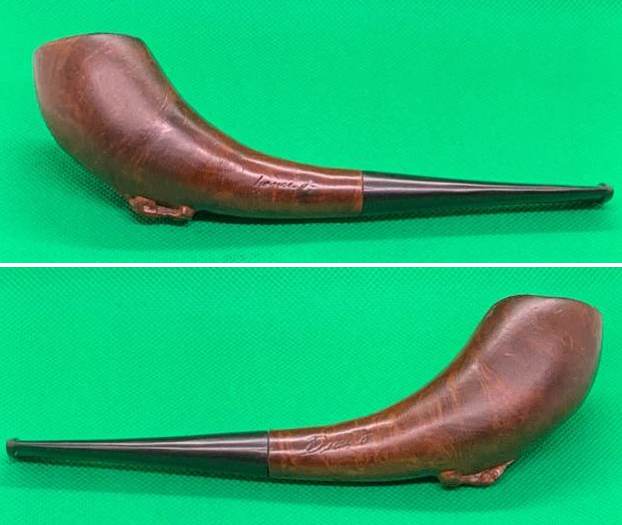 The next series of photos show the grain around the bowl and the stamping on the shank sides.
The next series of photos show the grain around the bowl and the stamping on the shank sides.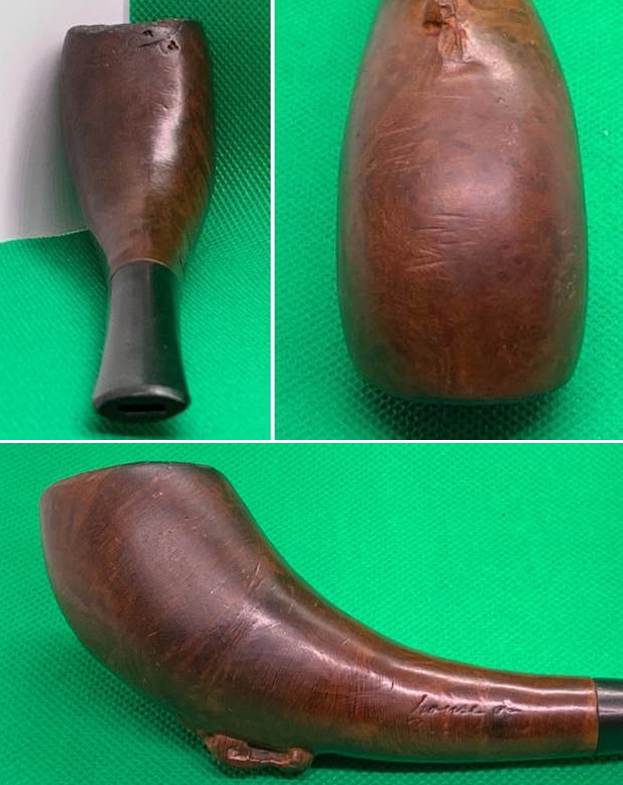 He included photos of the stamping on the sides of the shank and the carving on the underside of the shank.
He included photos of the stamping on the sides of the shank and the carving on the underside of the shank.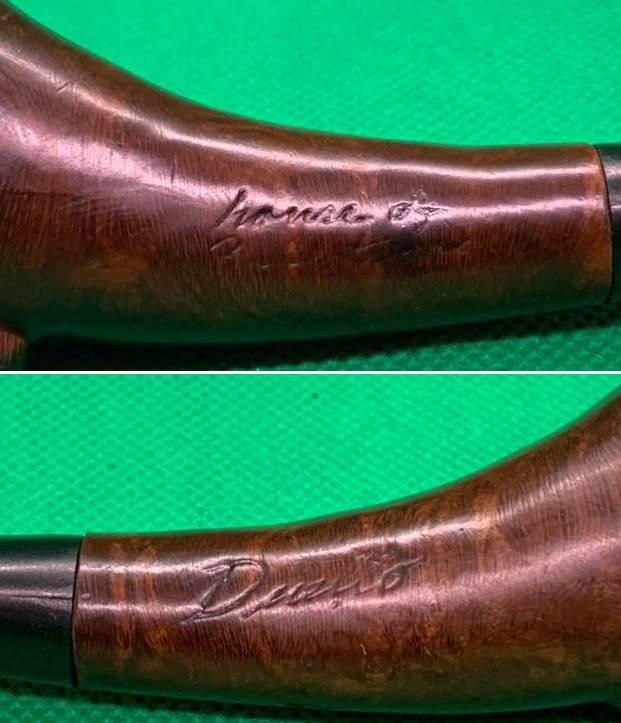
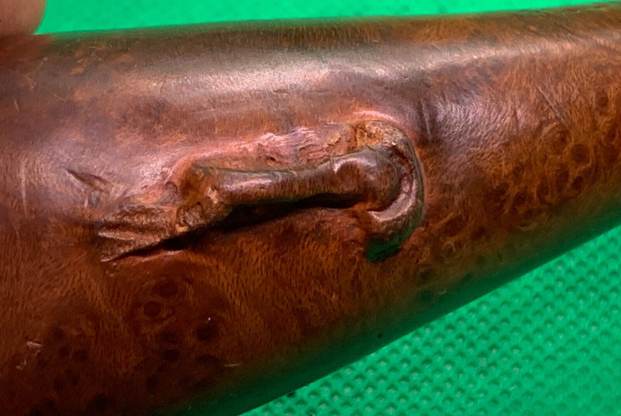 The stem had tooth marks and wear on both sides ahead of the button and on the surface of the button itself.
The stem had tooth marks and wear on both sides ahead of the button and on the surface of the button itself.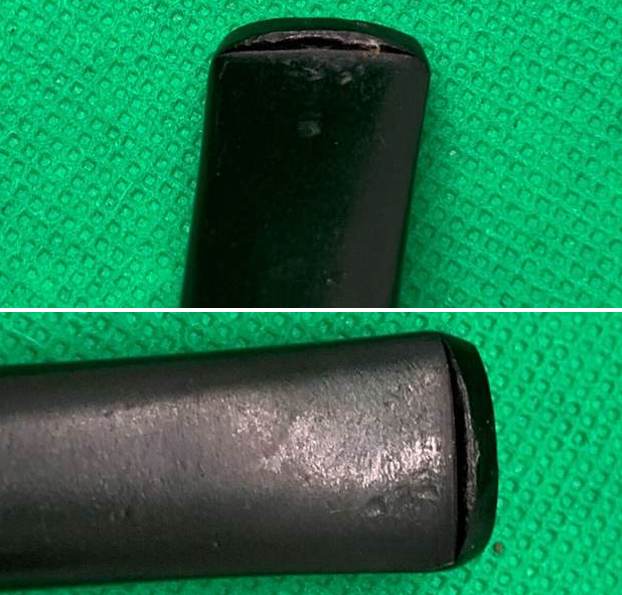 He included a photo of the bowl with the stem removed. It is a pipe with a lot of potential.
He included a photo of the bowl with the stem removed. It is a pipe with a lot of potential.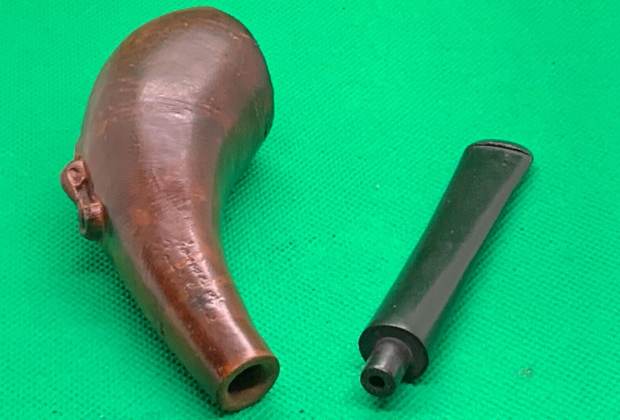 The pipe has the name House of Robertson roughly hand-etched on the left side of the shank with an engraving tool. I am including the information that I found when I received my first of the House of Robertson Pipes. I found a link on Pipedia (https://pipedia.org/wiki/Robertson) that gave me the only information I could find on the brand. I include that in total as it is interesting to read.
The pipe has the name House of Robertson roughly hand-etched on the left side of the shank with an engraving tool. I am including the information that I found when I received my first of the House of Robertson Pipes. I found a link on Pipedia (https://pipedia.org/wiki/Robertson) that gave me the only information I could find on the brand. I include that in total as it is interesting to read.
“House of Robertson” was in business for many years, but alas, closed their doors in 1999. They were located in Boise, Idaho. They are noted for making rather large and interesting pipes. Thayne Robertson was a Master Mason, AF & AM, and started the shop about 1947 and his son Jon started working there in 1970 when he finished college, along with Thayne’s daughter. Thayne and his son started making the big pipes at that time, and made them together until 1987 when Thayne passed away. Jon kept the store and his sister moved on to other things. The House of Robertson appears to have closed around 1999.
When Jeff received the pipe he took photos of it to capture what it looked like when he removed it from the box. The pipe was dirty but underneath all of the grime it seemed like it has some nice grain around the bowl and shank. The rim top and edges of the bowl had been badly abused and beat up and showed chips and wear. There was a thick cake in the bowl and an overflow on the top and edges. There were a lot of scratches and cuts in the briar around the bowl sides and shank. The carving of the vine and grapes at the back top of the bowl is quite damaged as is the “carved vine” on the bottom of the bowl. The pipe has seen a lot of rough travel since the day it left Robertson’s pipe shop in Boise, Idaho. The fit of the stem to the shank is snug and looks good. There were casting marks on the left and right sides of the stem at the shank union that make me think it is a replacement stem. There is also a chipped area on the underside of the shank where it appears the stem had been pried away at some point. The tenon on the stem was incredibly short given the depth of the mortise. There were tooth marks on both sides of the stem ahead of the button and on the button surface itself. Jeff took the following photos of the pipe to show its condition when he received it.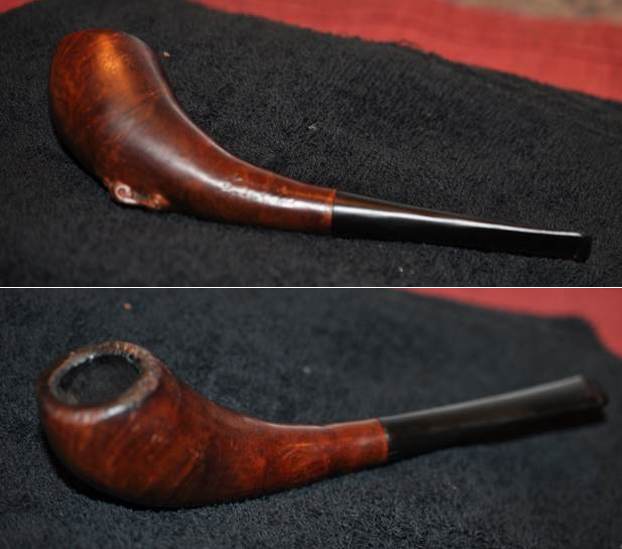 The next close-up photos show the condition of the bowl and the rim top. They show the cake in the bowl and the lava overflowing onto the rim top. You can also see how beat up the rim top is. It is in rough condition. The edges are also chipped and damaged. The photos of the stem show the tooth mark and tooth marks on both sides of the stem.
The next close-up photos show the condition of the bowl and the rim top. They show the cake in the bowl and the lava overflowing onto the rim top. You can also see how beat up the rim top is. It is in rough condition. The edges are also chipped and damaged. The photos of the stem show the tooth mark and tooth marks on both sides of the stem. 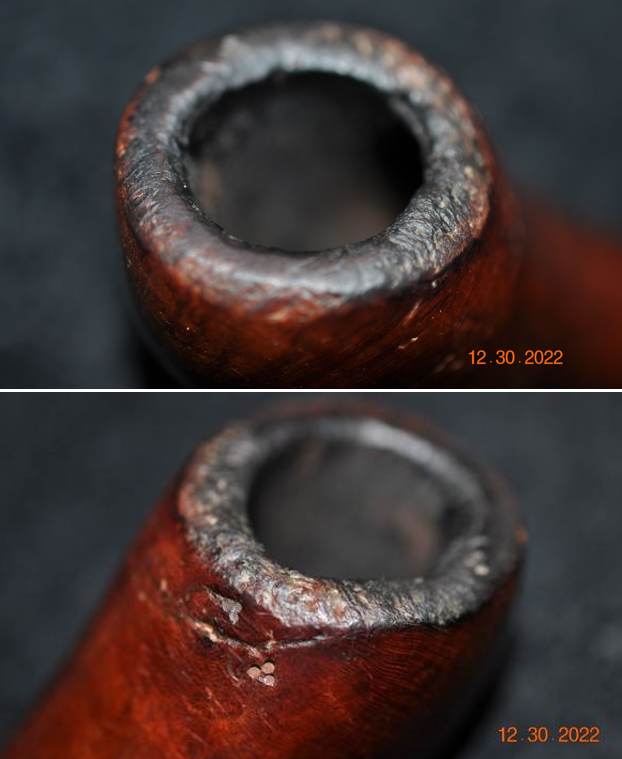
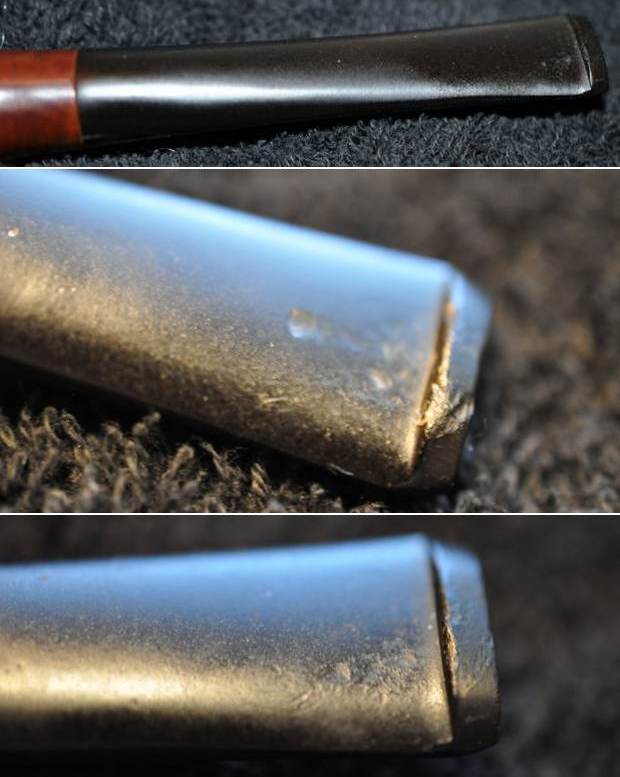 The photos of the sides and heel of the bowl show the grain and the nicks and scratches around the bowl and shank. The brown stain adds depth finish on the pipe. Even under the grime it is a unique piece.
The photos of the sides and heel of the bowl show the grain and the nicks and scratches around the bowl and shank. The brown stain adds depth finish on the pipe. Even under the grime it is a unique piece.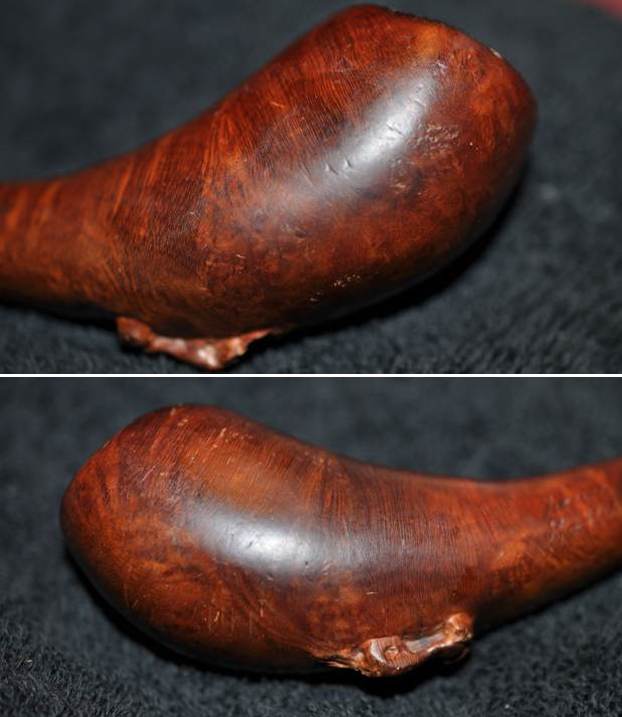
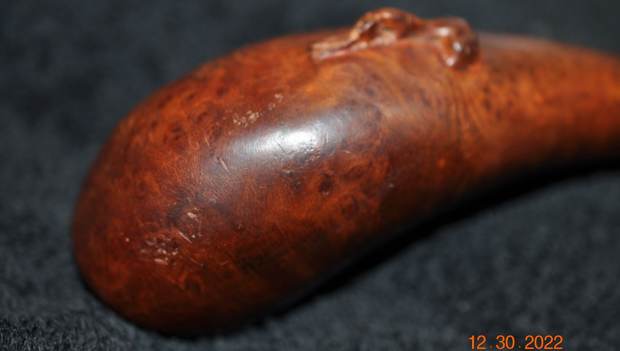 He also took photos of the carving on the underside of the shank. You can see the damage on the front side of the carving.
He also took photos of the carving on the underside of the shank. You can see the damage on the front side of the carving.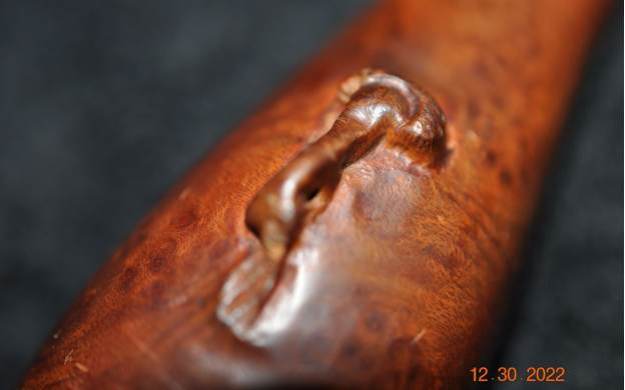
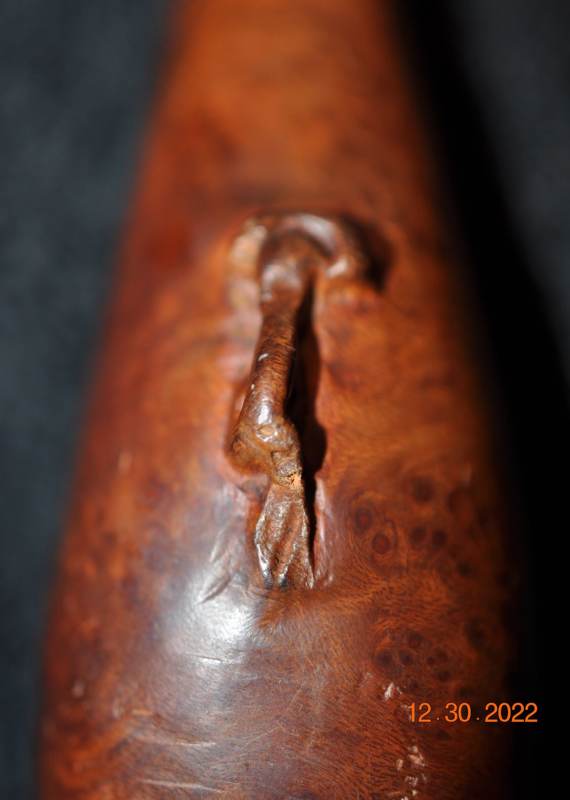 The next photo shows the etched name on the left side of shank. It reads House of Robertson. On the back top of the bowl you can see the condition of what appears to be a grape vine.
The next photo shows the etched name on the left side of shank. It reads House of Robertson. On the back top of the bowl you can see the condition of what appears to be a grape vine. 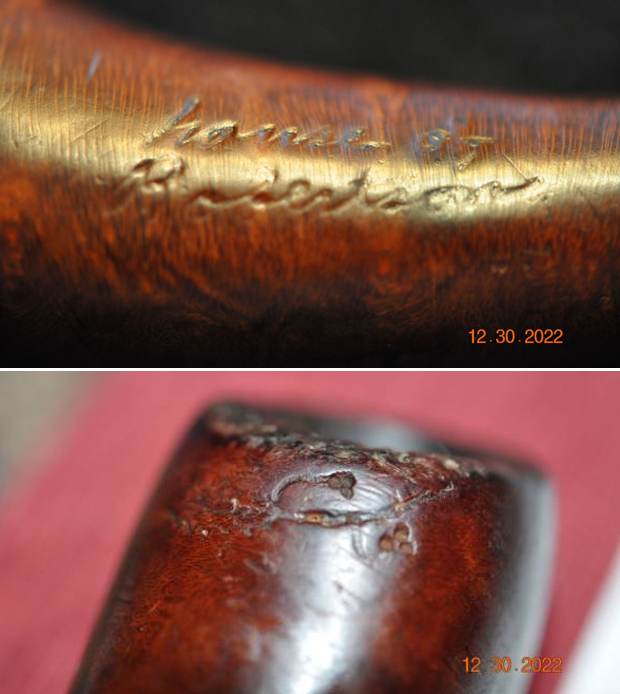 The more I looked at it the combination of grape vines, grapes and the thick branch on the underside of the shank make me think that the pipe is a drinking or wine horn. The shape is very reminiscent of the shape of the horn. It would really help if the stem had a bend in it. The carved vine on the rim edge, the carved chunk of fine on the underside seem to point in this direction.
The more I looked at it the combination of grape vines, grapes and the thick branch on the underside of the shank make me think that the pipe is a drinking or wine horn. The shape is very reminiscent of the shape of the horn. It would really help if the stem had a bend in it. The carved vine on the rim edge, the carved chunk of fine on the underside seem to point in this direction.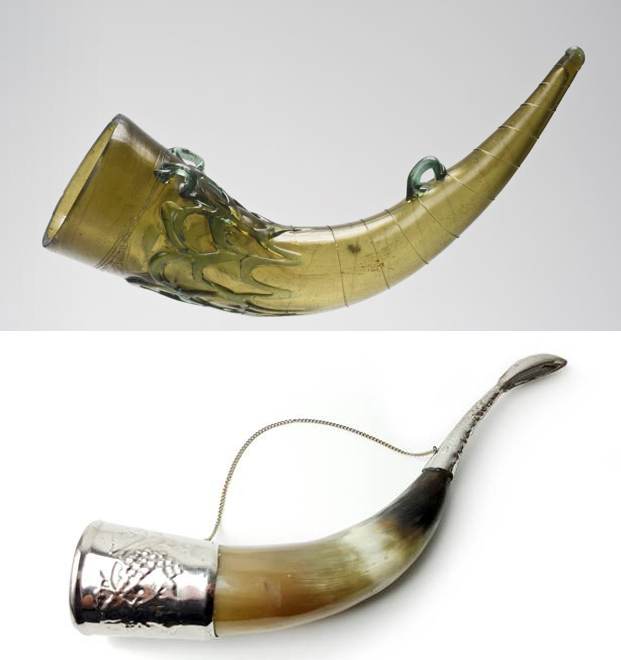 Jeff had thoroughly cleaned up the pipe. He reamed the pipe with a PipNet Pipe Reamer and cleaned up the remnants with a Savinelli Fitsall Pipe Knife. He scrubbed the bowl with undiluted Murphy’s Oil Soap with a tooth brush. He rinsed it under running warm water to remove the soap and grime. He cleaned out the inside of the shank and the airway in the stem with alcohol, cotton swabs and pipe cleaners. He scrubbed the exterior of the stem with Soft Scrub to remove the grime and calcification. He soaked the stem in Before & After Deoxidizer and rinsed it off with warm water. The pipe looked very good when it arrived here in Vancouver.
Jeff had thoroughly cleaned up the pipe. He reamed the pipe with a PipNet Pipe Reamer and cleaned up the remnants with a Savinelli Fitsall Pipe Knife. He scrubbed the bowl with undiluted Murphy’s Oil Soap with a tooth brush. He rinsed it under running warm water to remove the soap and grime. He cleaned out the inside of the shank and the airway in the stem with alcohol, cotton swabs and pipe cleaners. He scrubbed the exterior of the stem with Soft Scrub to remove the grime and calcification. He soaked the stem in Before & After Deoxidizer and rinsed it off with warm water. The pipe looked very good when it arrived here in Vancouver.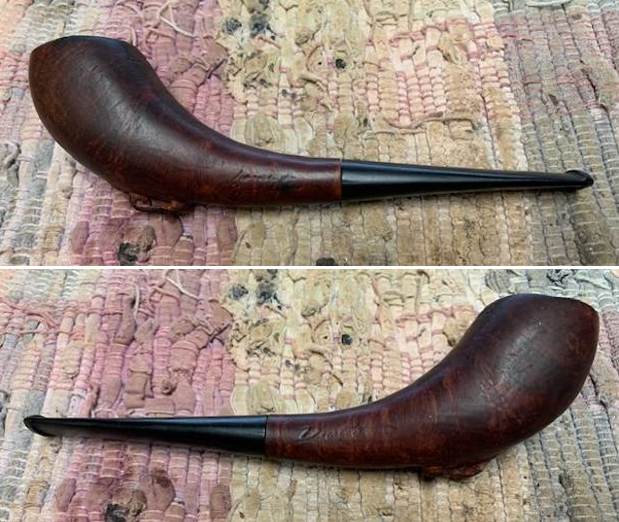
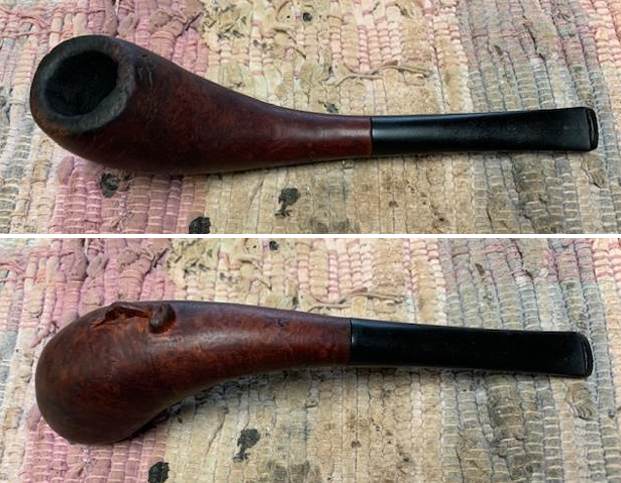 I took a photo of the bowl and rim top to show how clean the bowl and the rim top and inner edges of the bowl. I took photos of the stem surface to show the condition and tooth marks and chatter on both sides ahead of the button. You can see the chip or dented area where the stem meets the shank in the third photo below.
I took a photo of the bowl and rim top to show how clean the bowl and the rim top and inner edges of the bowl. I took photos of the stem surface to show the condition and tooth marks and chatter on both sides ahead of the button. You can see the chip or dented area where the stem meets the shank in the third photo below.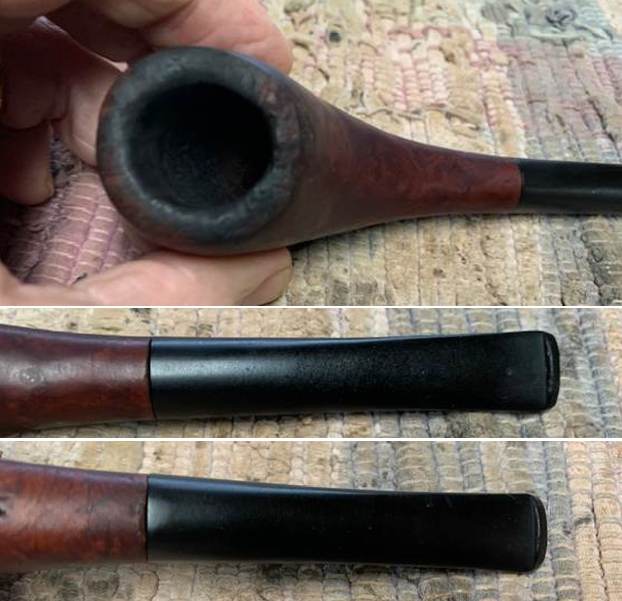 I took photos of the stamping on the shank sides (left, right and underside). It is readable as noted above and though faint is clear.
I took photos of the stamping on the shank sides (left, right and underside). It is readable as noted above and though faint is clear.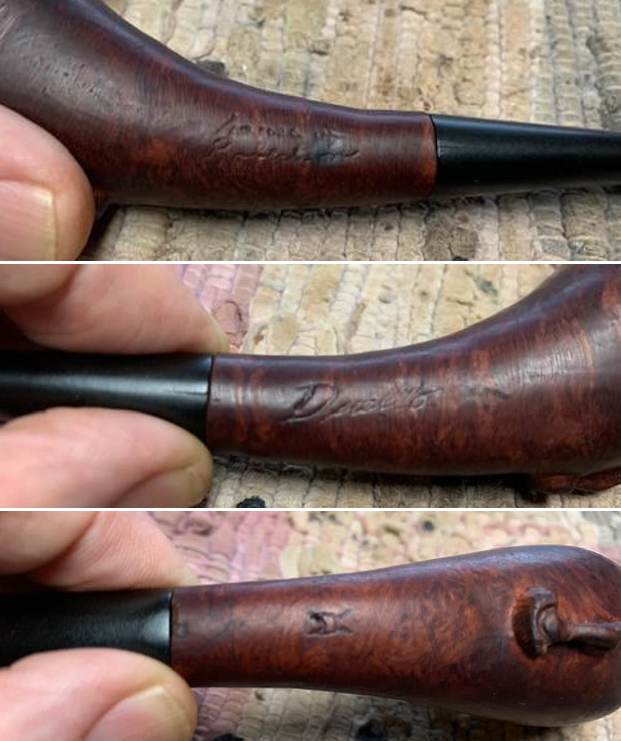 I removed the stem (note the short tenon) from the shank and took a photo of the pipe parts. It is a unique piece.
I removed the stem (note the short tenon) from the shank and took a photo of the pipe parts. It is a unique piece. 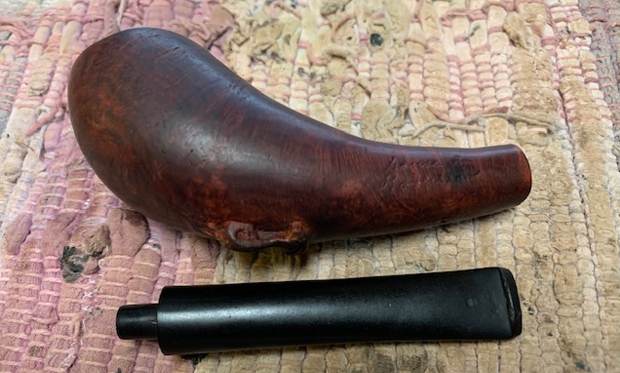 The bowl needed a lot of work. I would need to rework the rim top and the inner and outer edge of the bowl and the also sand out the deep gouges, scratches and file marks in the briar on the sides of the bowl. It really was a refinishing nightmare. I decided to start my work on the bowl by addressing the damaged rim top and edges. I topped the bowl to get a flat surface to start on. I used a topping board and 220 grit sandpaper. I then used a wooden ball and 220 grit sandpaper to give the inner edge a bevel inward. Doing that hid the damage on the inner edge of the bowl and blended it into the surface.
The bowl needed a lot of work. I would need to rework the rim top and the inner and outer edge of the bowl and the also sand out the deep gouges, scratches and file marks in the briar on the sides of the bowl. It really was a refinishing nightmare. I decided to start my work on the bowl by addressing the damaged rim top and edges. I topped the bowl to get a flat surface to start on. I used a topping board and 220 grit sandpaper. I then used a wooden ball and 220 grit sandpaper to give the inner edge a bevel inward. Doing that hid the damage on the inner edge of the bowl and blended it into the surface.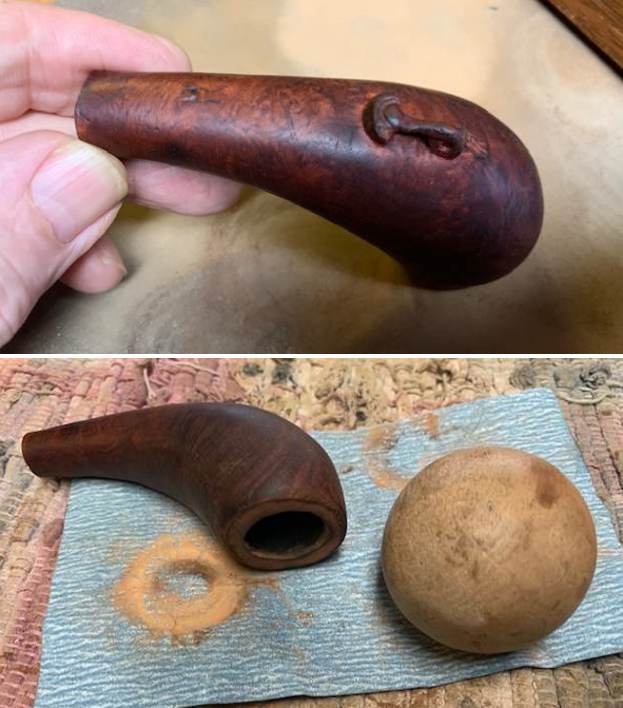
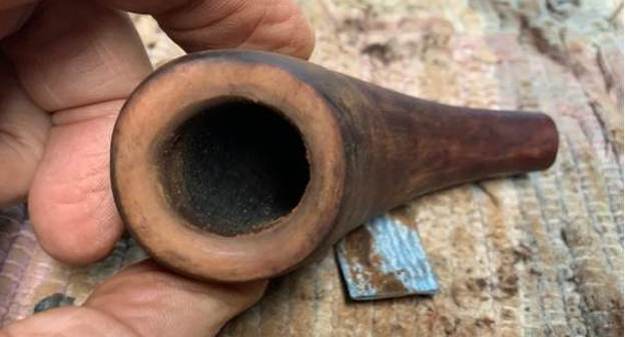 I sanded the bowl sides and shank with a folded piece of 220 grit sandpaper to smooth out and minimize the scratches and marks on the briar of the bowl and shank. It was beginning to look much better.
I sanded the bowl sides and shank with a folded piece of 220 grit sandpaper to smooth out and minimize the scratches and marks on the briar of the bowl and shank. It was beginning to look much better.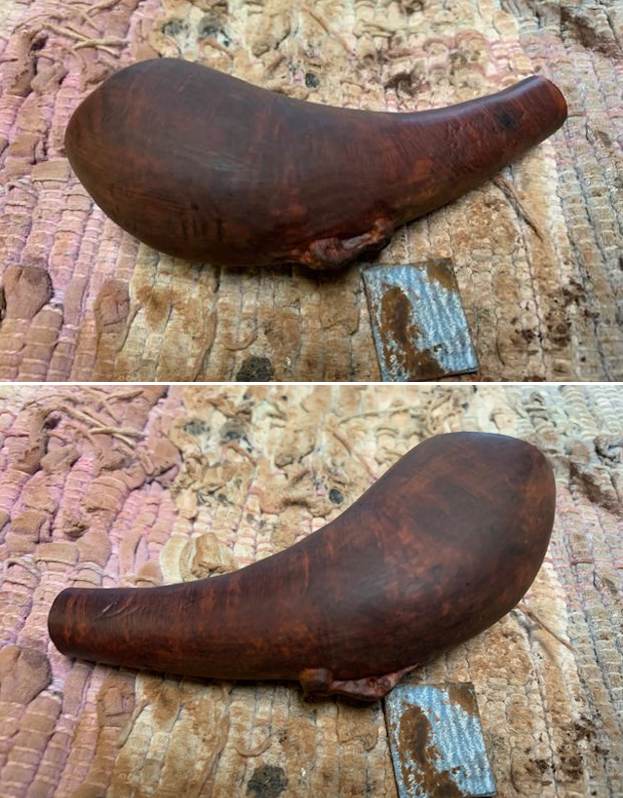
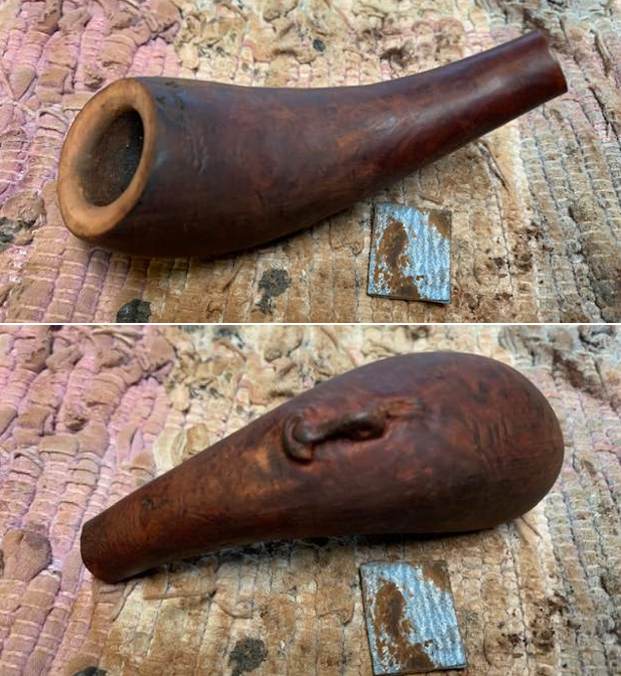 I wiped the bowl and rim top down with alcohol and cotton pads to remove the debris and the heavy stain coat that hid the grain. Once I had wiped it down the grain really stood out.
I wiped the bowl and rim top down with alcohol and cotton pads to remove the debris and the heavy stain coat that hid the grain. Once I had wiped it down the grain really stood out.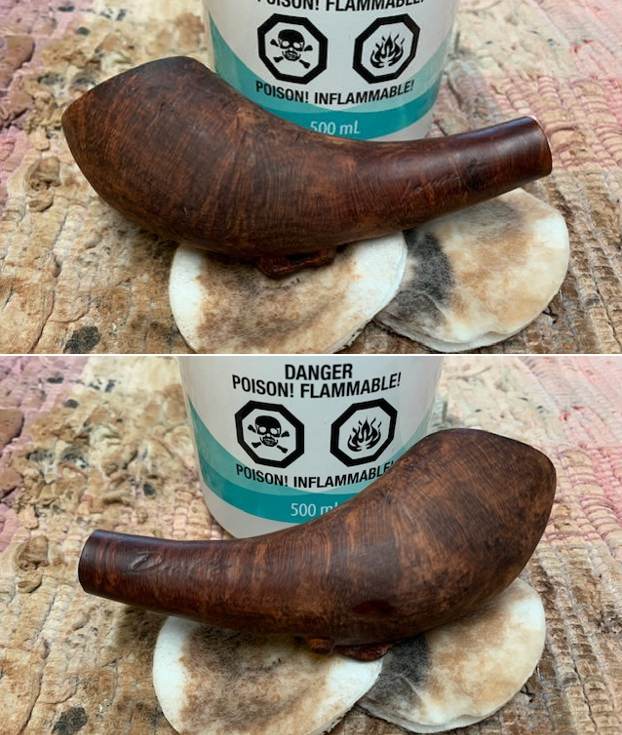
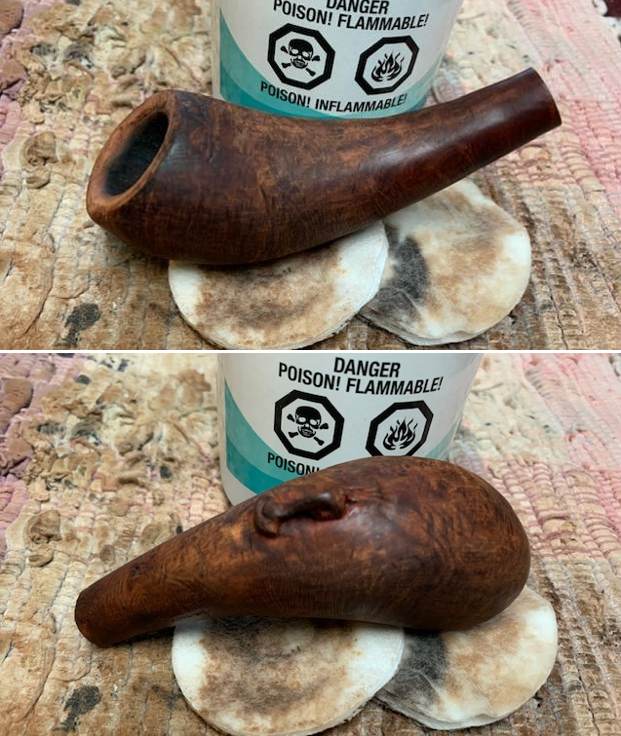 I used a medium and fine grit sanding pad to sand the bowl and rim top further. Once finished the pipe really started to show promise that I was hoping for in an other other wise mess of a pipe. The grain stood out better and the carving on top back of the bowl was clearly a vine and grapes. It looked much better.
I used a medium and fine grit sanding pad to sand the bowl and rim top further. Once finished the pipe really started to show promise that I was hoping for in an other other wise mess of a pipe. The grain stood out better and the carving on top back of the bowl was clearly a vine and grapes. It looked much better.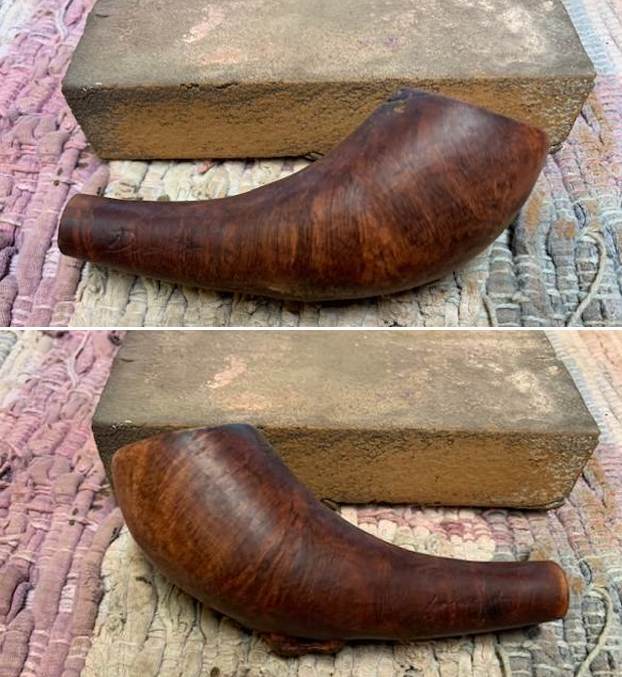 I needed a break from sanding the bowl so I set it aside and turned my attention to the stem. To start my work on it I decided to heat it and give it a slight bend in keeping with the look of the horn. When it was flexible I bent it and it snapped off in my hand – utter frustration!! That set me back a bit but in the long haul it was much better as I could use a stem with a longer tenon and a better fit to the shank. I went through my can of stems and found a stem with the right bend, the right tenon sized and length for the shank and that would only need a little adjustment to the diameter to make it fit.
I needed a break from sanding the bowl so I set it aside and turned my attention to the stem. To start my work on it I decided to heat it and give it a slight bend in keeping with the look of the horn. When it was flexible I bent it and it snapped off in my hand – utter frustration!! That set me back a bit but in the long haul it was much better as I could use a stem with a longer tenon and a better fit to the shank. I went through my can of stems and found a stem with the right bend, the right tenon sized and length for the shank and that would only need a little adjustment to the diameter to make it fit.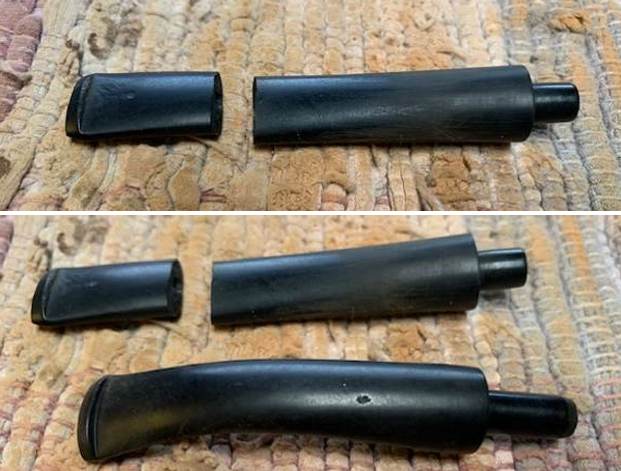 I put the stem on the shank and took photos of the new look of the pipe. You can see that the diameter of the stem is slightly larger than the diameter of the shank. But I liked the look of the new stem and the angles of the bend it really is looking like a drinking/wine horn.
I put the stem on the shank and took photos of the new look of the pipe. You can see that the diameter of the stem is slightly larger than the diameter of the shank. But I liked the look of the new stem and the angles of the bend it really is looking like a drinking/wine horn.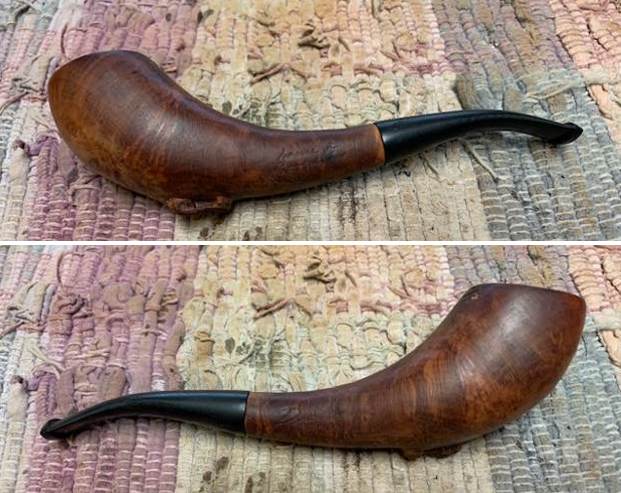
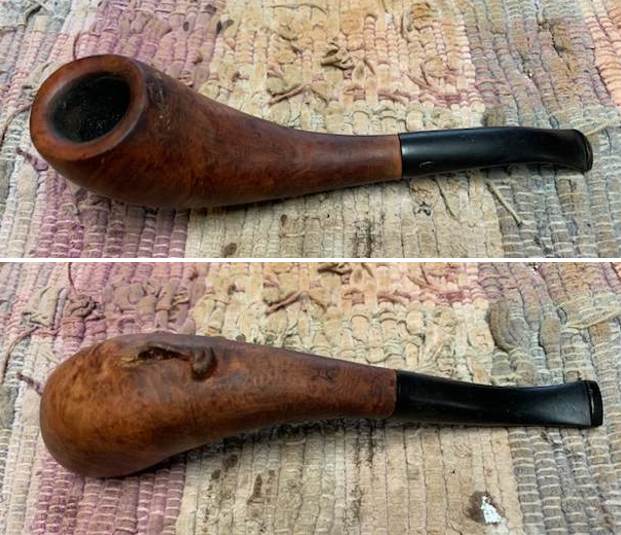 I sanded the diameter of the stem with 220 grit sandpaper to reduce it to the same diameter as the shank. Once the stem was adjusted in diameter it looked very good. I sanded the entire stem including the light tooth chatter at the button with 220 grit sandpaper to smooth out the stem.
I sanded the diameter of the stem with 220 grit sandpaper to reduce it to the same diameter as the shank. Once the stem was adjusted in diameter it looked very good. I sanded the entire stem including the light tooth chatter at the button with 220 grit sandpaper to smooth out the stem.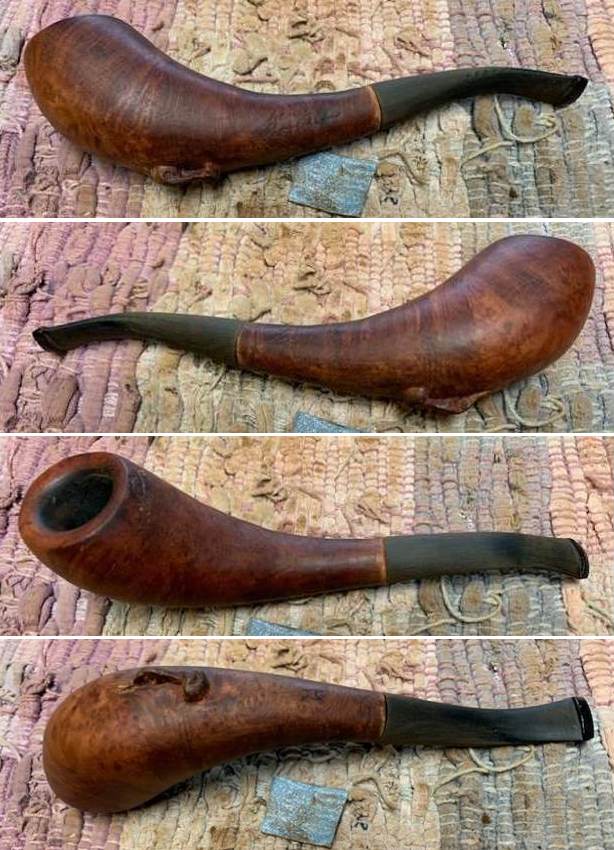 I removed the stem from the shank and continued sanding out the tooth marks and chatter at the button and smoothing out and shaping the shank end of the stem. Once I was happy with the fit and look of the stem I started polishing it with 600 grit wet dry sandpaper.
I removed the stem from the shank and continued sanding out the tooth marks and chatter at the button and smoothing out and shaping the shank end of the stem. Once I was happy with the fit and look of the stem I started polishing it with 600 grit wet dry sandpaper.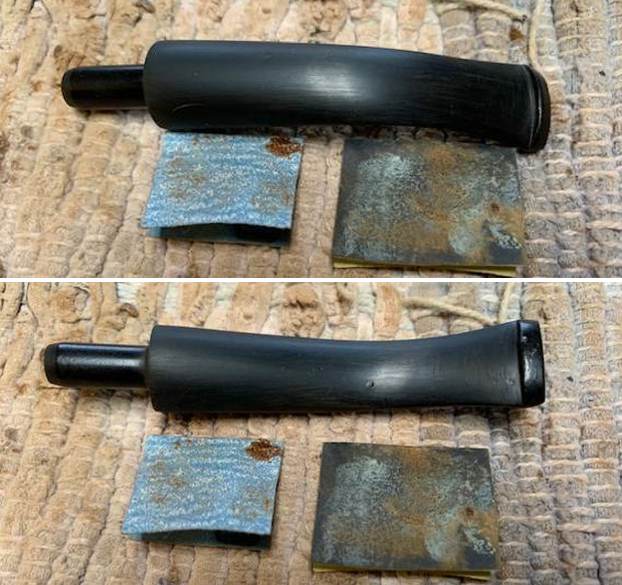
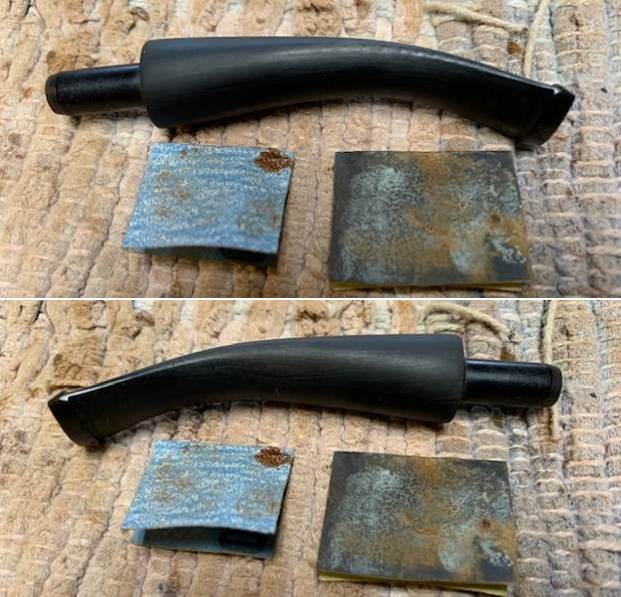 I took photos of the underside of the shank stem junction to show the damage that I noted above – the chip out of the underside of the shank. It made the fit against the underside of the shank a challenge that gave me two options to address. I could either use the topping board to flatten it or I could put a thin band on the shank.
I took photos of the underside of the shank stem junction to show the damage that I noted above – the chip out of the underside of the shank. It made the fit against the underside of the shank a challenge that gave me two options to address. I could either use the topping board to flatten it or I could put a thin band on the shank.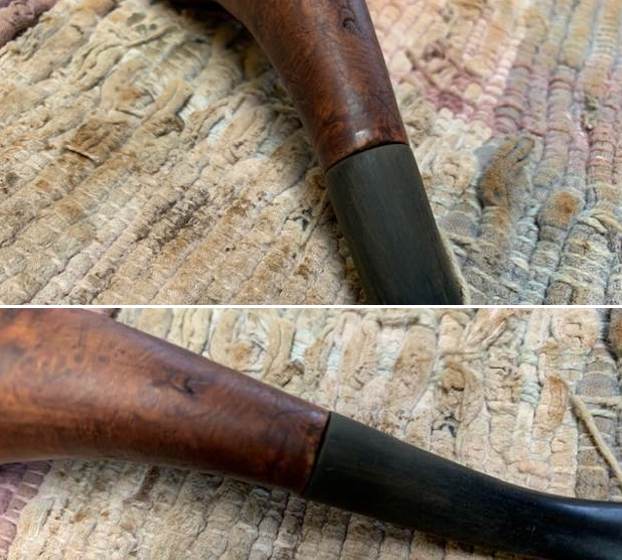 I tried to top the shank end a bit on the topping board with 220 grit sandpaper but it did not solve the problem as the chip went quite deep into the underside. I decided to go with a thin brass band on the shank end to repair the damage on the end of the shank. I heated the band and pressed in place on the shank. It gave the shank a flat face for the stem to sit against. I liked the look of the bling and the fit of the stem against it. (A passing comment. Can you see the wine cup in the stamp on the shank in the first photo.
I tried to top the shank end a bit on the topping board with 220 grit sandpaper but it did not solve the problem as the chip went quite deep into the underside. I decided to go with a thin brass band on the shank end to repair the damage on the end of the shank. I heated the band and pressed in place on the shank. It gave the shank a flat face for the stem to sit against. I liked the look of the bling and the fit of the stem against it. (A passing comment. Can you see the wine cup in the stamp on the shank in the first photo.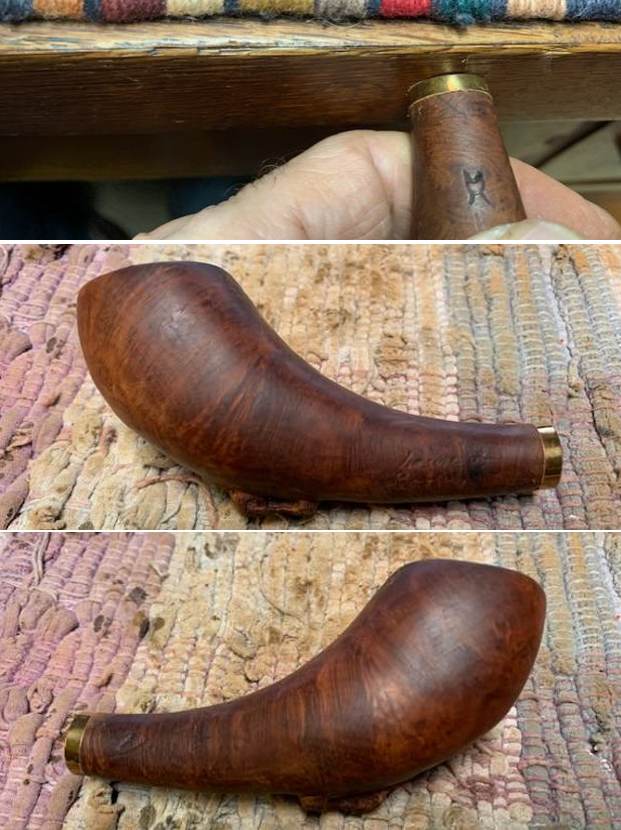
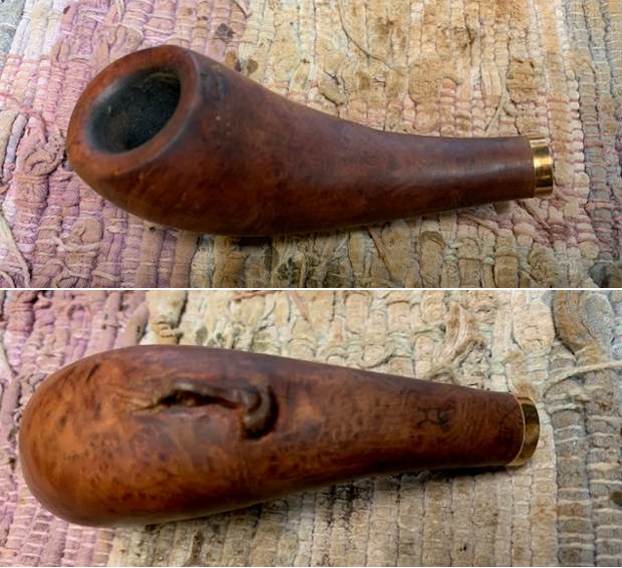 I put the fitted stem in place on the shank and took photos of the look of the pipe at this point in the process. It looks far better than when I started.
I put the fitted stem in place on the shank and took photos of the look of the pipe at this point in the process. It looks far better than when I started. 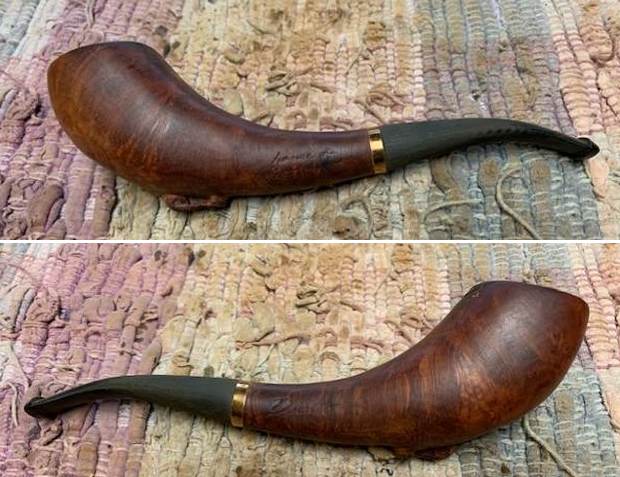
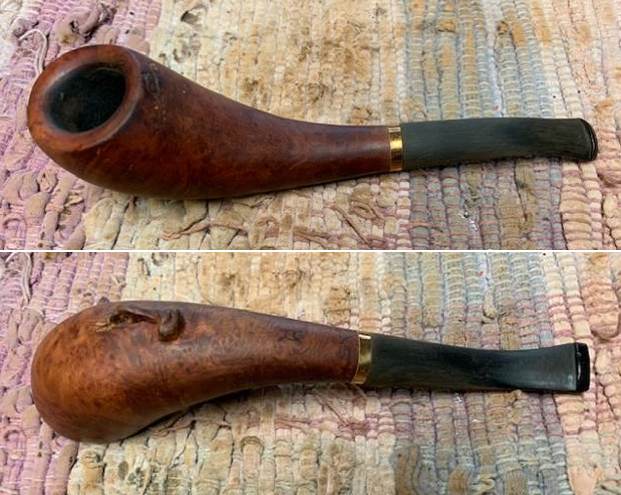 Now it was time to polish the bowl and shank with micromesh sanding pads – dry sanding with 1500-12000 grit pads. I wiped the bowl down after each pad to remove the grit. The bowl began to take on a rich shine. It is a beauty.
Now it was time to polish the bowl and shank with micromesh sanding pads – dry sanding with 1500-12000 grit pads. I wiped the bowl down after each pad to remove the grit. The bowl began to take on a rich shine. It is a beauty.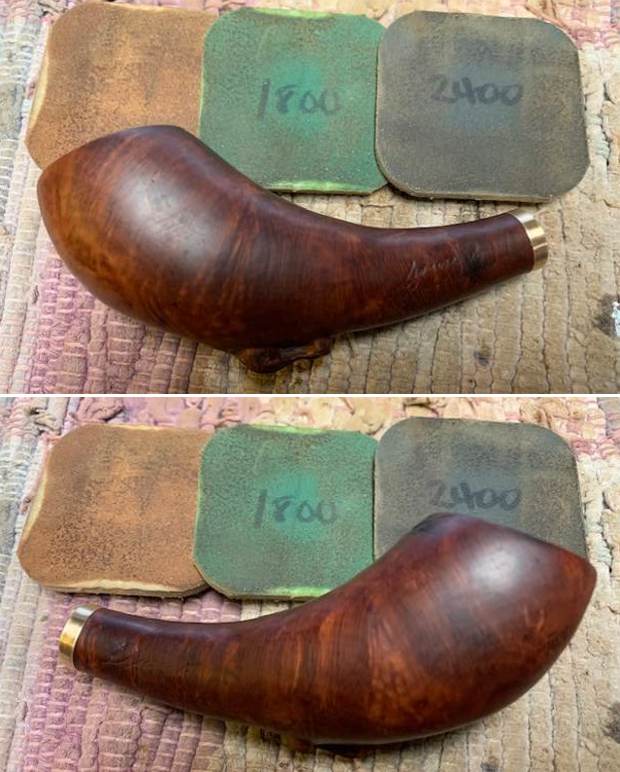
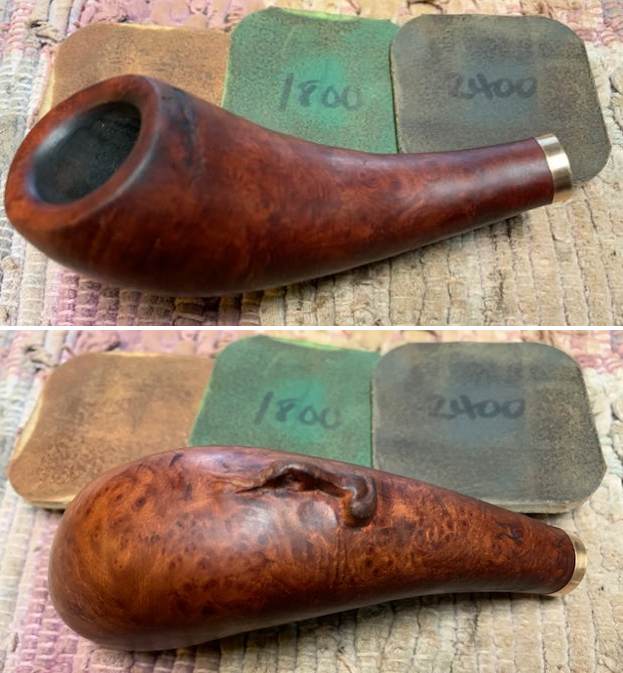 I used a Black stain pen to darken the vine and the grapes on the back side of the bowl and the stamping on the shank sides to highlight the House of Robertson and the Duello stamp. Once they were stained I used the remainder of the micromesh pads to clean up the excess black.
I used a Black stain pen to darken the vine and the grapes on the back side of the bowl and the stamping on the shank sides to highlight the House of Robertson and the Duello stamp. Once they were stained I used the remainder of the micromesh pads to clean up the excess black. 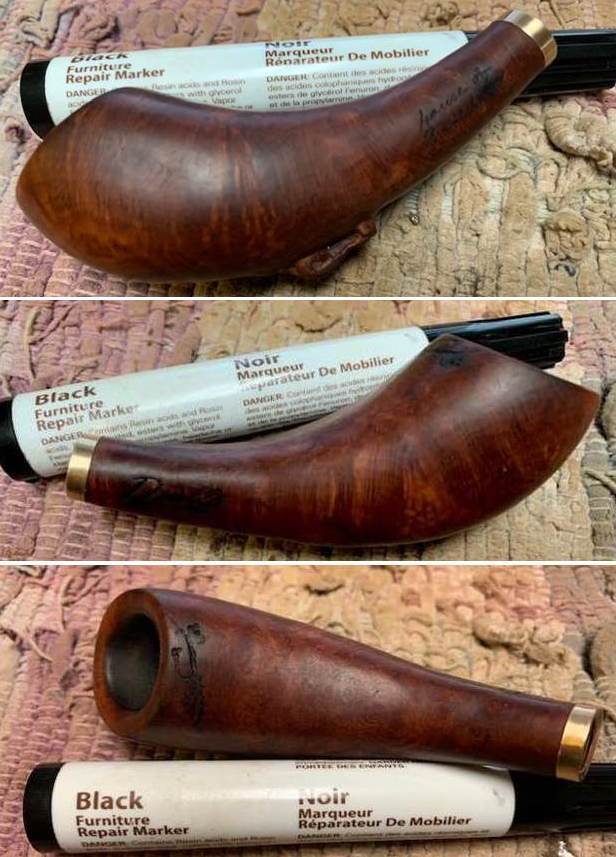
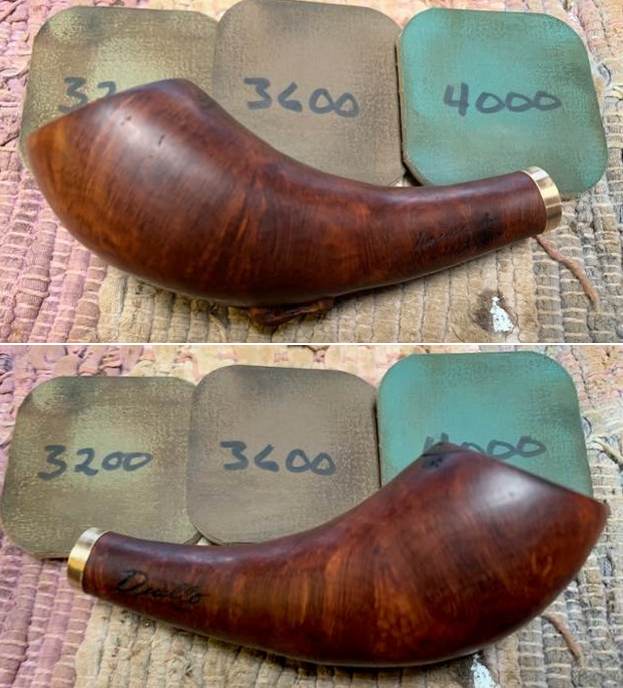
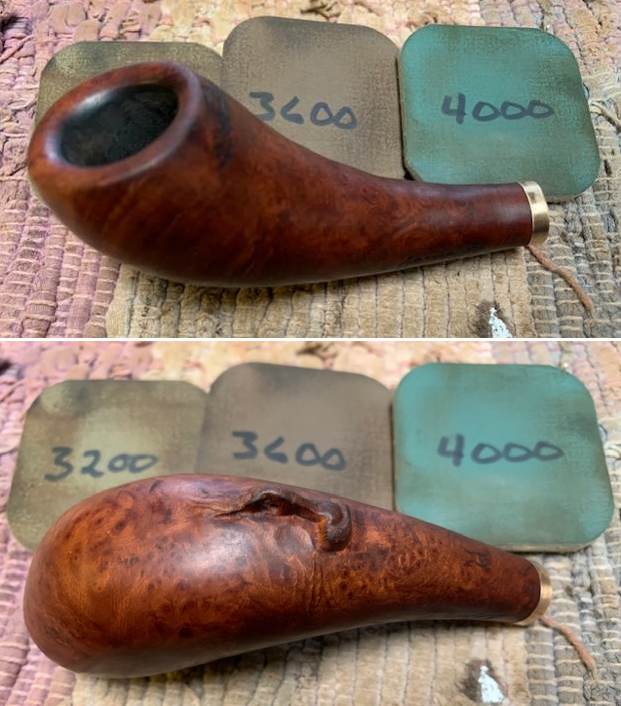
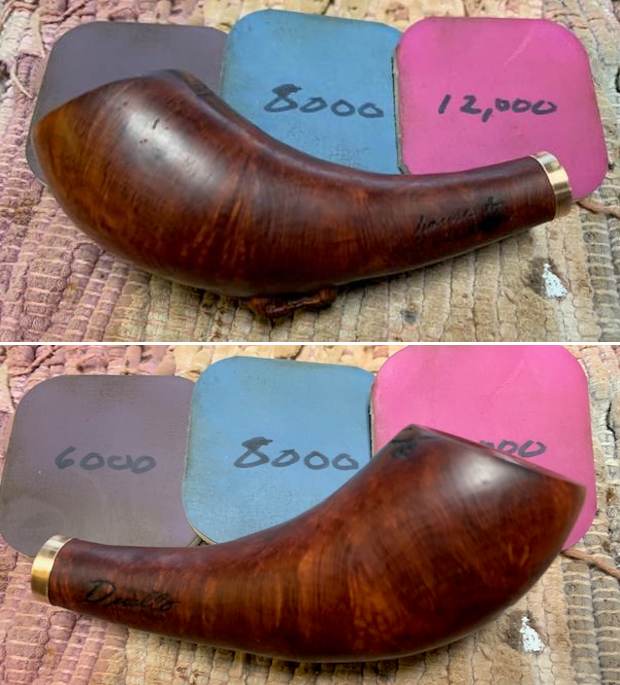
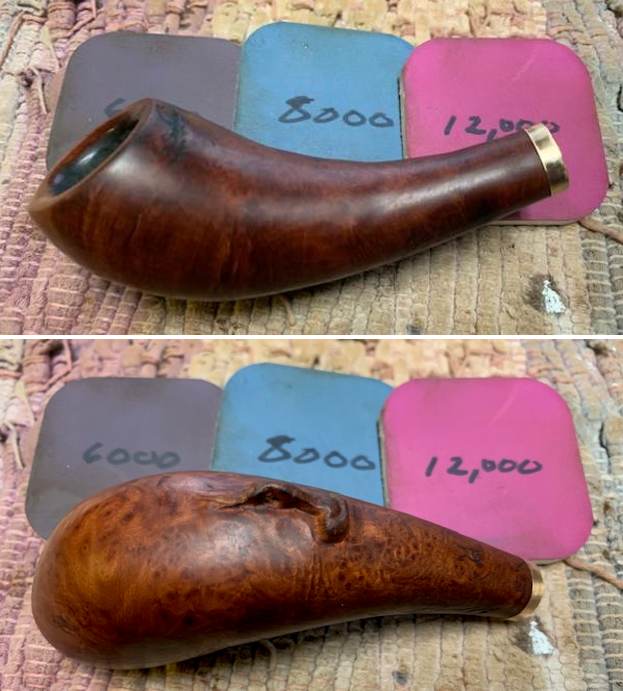 I worked Before & After Restoration Balm deep into the nooks and crannies of the carvings to clean, enliven and protect the briar. I hand rubbed it with my fingers and worked it into the finish with a horsehair shoe brush. I wiped it off with a soft cloth. I buffed the bowl with a cotton cloth to polish it. It really began to have a deep shine in the briar. I took some photos of the bowl at this point to mark the progress in the restoration.
I worked Before & After Restoration Balm deep into the nooks and crannies of the carvings to clean, enliven and protect the briar. I hand rubbed it with my fingers and worked it into the finish with a horsehair shoe brush. I wiped it off with a soft cloth. I buffed the bowl with a cotton cloth to polish it. It really began to have a deep shine in the briar. I took some photos of the bowl at this point to mark the progress in the restoration. 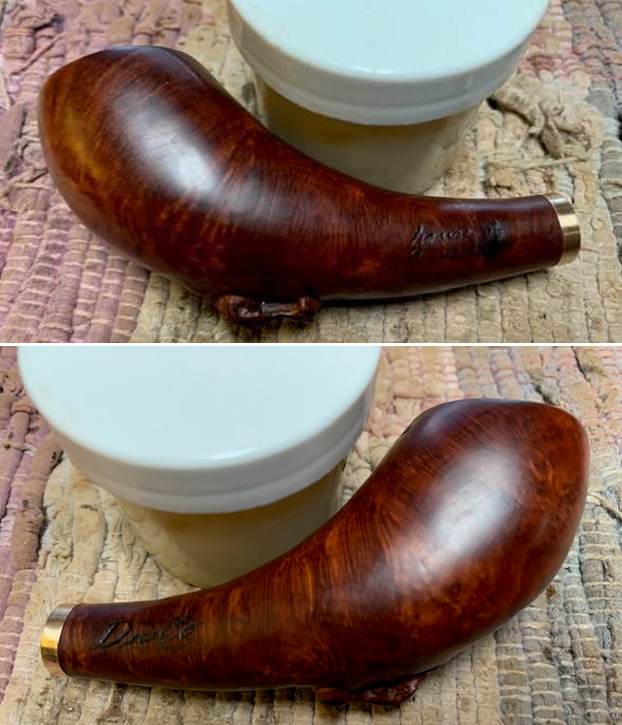
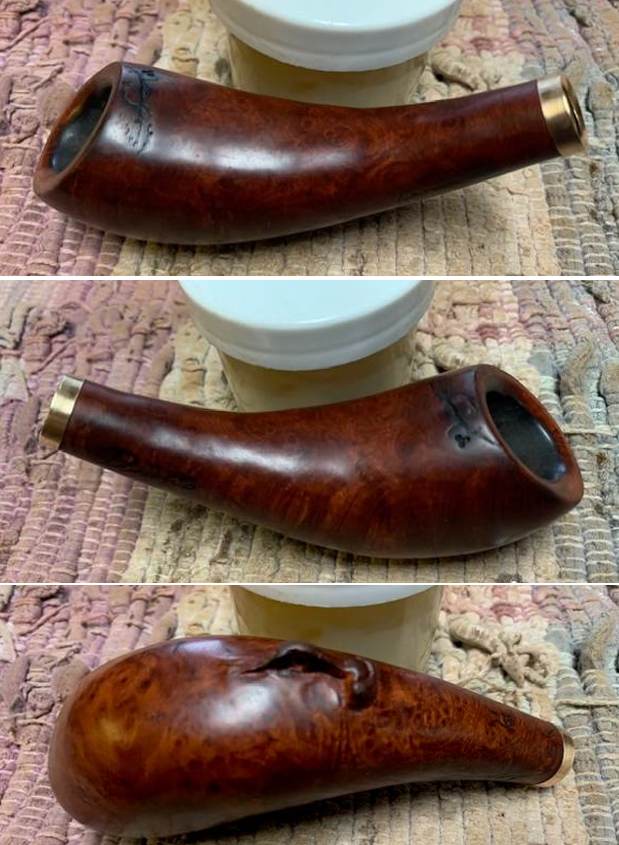
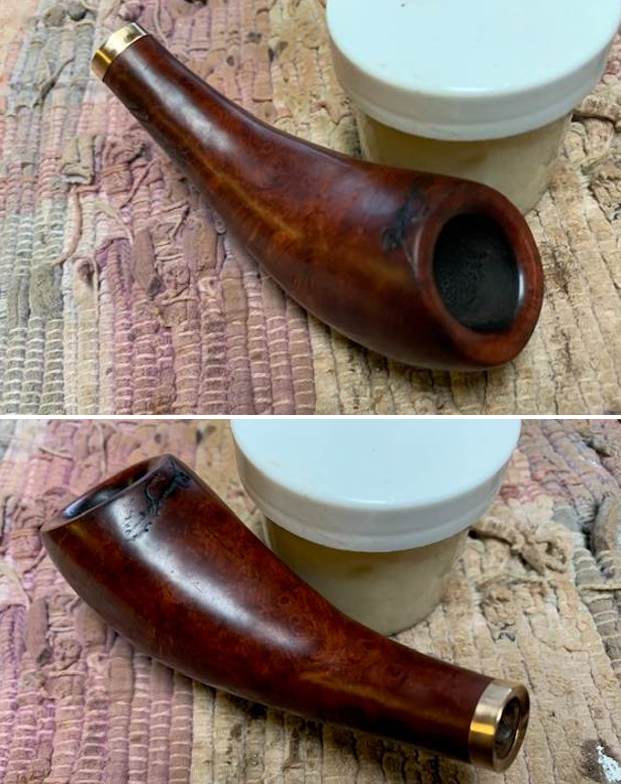 I polished the stem with micromesh sanding pads – 1500-12000 grit pads. I wiped it down with a damp cloth after each sanding pad. I used Before & After Pipe Polish – both Fine and Extra Fine to further polish the stem.
I polished the stem with micromesh sanding pads – 1500-12000 grit pads. I wiped it down with a damp cloth after each sanding pad. I used Before & After Pipe Polish – both Fine and Extra Fine to further polish the stem.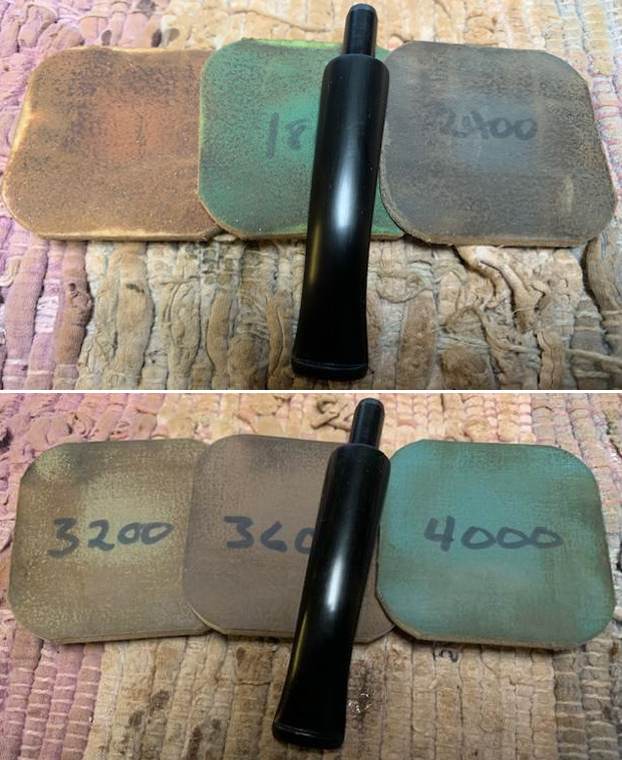
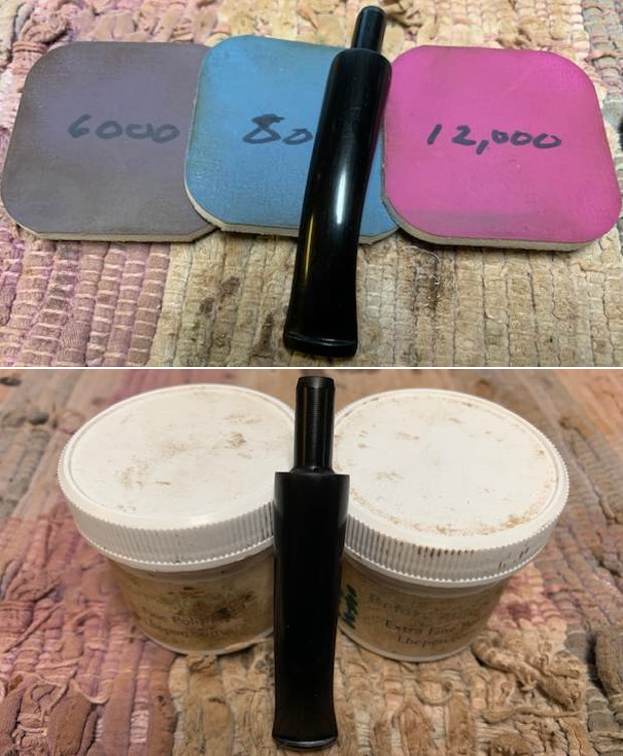 I put the House of Robertson Drinking Horn back together and worked the pipe over on the buffing wheel using Blue Diamond to lightly polish the stem. I buffed the bowl with a light touch so as not to get any of the buffing compounds in the grooves of the rustication. I buffed the stem to raise the gloss on the vulcanite. I gave the bowl and the stem multiple coats of carnauba wax. I buffed the entire pipe with a clean buffing pad to raise the shine. I hand buffed it with a microfiber cloth to deepen the shine. The finished HOR Drinking Horn is shown in the photos below. The medium brown stains on the well grained briar worked well with the brass band and the bent black of the vulcanite stem. The polishing and the reworking of the stem material left this a beautiful and interesting looking pipe. The dimensions of the pipe are: Length: 7 inches, Height: 2 inches, Outside Diameter: 1 ¼ inches, Diameter of the chamber: 7/8 inches. The weight of the pipe is 1.69 ounces/ 48 grams. This would be a great addition to the collection of a House of Robertson collector. If you are interested in adding it to your collection it will be on the rebornpipes store in the American (US) Pipemakers Section shortly. Thanks for looking.
I put the House of Robertson Drinking Horn back together and worked the pipe over on the buffing wheel using Blue Diamond to lightly polish the stem. I buffed the bowl with a light touch so as not to get any of the buffing compounds in the grooves of the rustication. I buffed the stem to raise the gloss on the vulcanite. I gave the bowl and the stem multiple coats of carnauba wax. I buffed the entire pipe with a clean buffing pad to raise the shine. I hand buffed it with a microfiber cloth to deepen the shine. The finished HOR Drinking Horn is shown in the photos below. The medium brown stains on the well grained briar worked well with the brass band and the bent black of the vulcanite stem. The polishing and the reworking of the stem material left this a beautiful and interesting looking pipe. The dimensions of the pipe are: Length: 7 inches, Height: 2 inches, Outside Diameter: 1 ¼ inches, Diameter of the chamber: 7/8 inches. The weight of the pipe is 1.69 ounces/ 48 grams. This would be a great addition to the collection of a House of Robertson collector. If you are interested in adding it to your collection it will be on the rebornpipes store in the American (US) Pipemakers Section shortly. Thanks for looking.